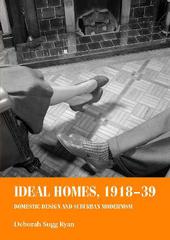
|
Ideal Homes, 1918-39: Domestic Design and Suburban Modernism
Hardback
Main Details
Description
This book focuses on the housebuilding boom of the interwar years, when Britain became a nation of homeowners. It investigates the ways in which ordinary people expressed new class and gender identities through the design, architecture and decoration of interwar homes then and now. It argues that these 'ideal' homes combine nostalgia for the past and longing for the future resulting in a new specifically suburban modernism. -- .
Author Biography
Deborah Sugg Ryan is Professor of Design History and Theory, and Associate Dean (Research) in the Faculty of Creative and Cultural Industries at the University of Portsmouth. She is also a contributor for BBC2's A House Through Time. -- .
Reviews'A fascinating book, dealing with a range of themes, including class, gender, empire, taste, good design, efficiency and nostalgia, which are linked to the idea of 'suburban modernity' in Britain and its material manifestations in suburban houses and their interiors. Sugg Ryan succeeds in evoking the material culture of a past era which, in certain ways, resonates strongly with our own.' Professor Penny Sparke, Kingston University 'Ideal Homes is a superb evocation of interwar living as expressed in its homes and furnishings. Deborah Sugg Ryan's new book skilfully interweaves social and design history and beautifully melds the academic and personal. Her exploration of 'suburban modernity' and its idiosyncratic blend of tradition and novelty, home and Empire, challenges the intellectual condescension of critics to find meaning and value in the lived experience of consumers and the messy, sometimes contradictory, choices they made. Along the way, it charts both the apparently rigid boundaries of gender and seemingly more fluid divisions of class. It's that rare thing - a book that will appeal to academic specialists and the general reader.' John Boughton - independent scholar and author of Municipal Dreams (2018) 'The long-running Studies in Design and Material Culture series focuses on the history of design and material culture in Britain between the two world wars. Grounding her discussion in the discipline of design history, Ryan (University of Portsmouth, UK) explores the aspirations and tastes of new suburban communities in England during the interwar period. Four individual stories of home ownership and homemaking reveal different aspects of emotional investment in domestic design and the drive for individuality. The author investigates how the design and decoration of these domestic spaces forged gender identities and a new suburban class. The book builds off the author's extensive doctoral research on Britain's annual Ideal Home Exhibitions, a show begun in 1908 by the Daily Mail and sponsored by it for a century. Plenty of contemporaneous photographs and drawings sprinkled throughout the volume clarify and reinforce the text.' R. P. Meden, Marymount University, CHOICE, Vol. 56, No. 4 (December 2018) 'Deborah Sugg Ryan's book makes an important contribution to the history of design as it was experienced by lower-middle-class and middle-class consumers in Great Britain in between the two World Wars. Weaving a narrative out of such varied sources as the Daily Mail's Ideal Home exhibitions, period advertisements for new housing developments, women's domestic advice literature, and the individual histories captured in the Mass Observation Archive, she presents a history of the architectural style and interior design practices of new suburban developments in the 1920s and 1930s [...] Sugg Ryan's book makes an important contribution to our understanding of the complexities of Modernism in interwar Britain. She reminds us to study objects and architectural designs that fall outside of the canon of Modernism and asks us to reconsider how we actually define Modernism.' Kristina Wilson, Journal of Design History (2019) 'Deborah Sugg Ryan's book begins with the personal and then develops into a fascinating and detailed study of housing design and the meanings of home in interwar Britain. These interesting intersections between the subjective, design history and a social history of the home makes for a gratifyingly fresh take on the history of housing design and domesticity during the years 1918 to 1939. Adopting this original approach readers are introduced to the world of the interwar house by Sugg Ryan as she reflects back on the house she purchased and moved into in 1995, no. 17 Rosamund Road, Wolvercote, Oxford [...]The book is well written, convincingly argued and successfully merges design history, social and gender history in what is undoubtedly an important new contribution to twentieth-century British history.' Dr Caitriona Beaumont, London South Bank University, Cercles: Revue pluridisciplinaire du monde anglophone '[Deborah Sugg Ryan's] new book covers the type of content and arguments rarely seen in publications on modern design history: the invisibility of certain styles, their potential for inclusion and a commensurate re-evaluation of significance[.] Keeping ordinary people's histories, rather than heroic architects' and designers', at the heart of her work distinguishes this book from others. The findings are shaped by primary sources, rather than locating examples to fit "predetermined theories of Modernism and modernity", allowing the importance of home ownership, decoration and social standing to determine the outcomes. This book succeeds in contesting the exclusion zones design history has placed on what Kjetil Fallan, an academic leader in the discipline, calls "the vast masses of modern material culture not conforming to the modernist ethos", with Sugg Ryan calling the field to account in its pursuit of the endorsement of the Modernist Movement alone, with the exceptions escaping these narrow parameters few and recent. When the author refers to multiple modernisms that are inclusive of interwar 'medieval modernism', 'liveable modernism' and 'amusing styles', you can be sure this book is going to open the reader to entirely new and unconstrained ways of thinking about suburban interior decoration.' Catriona Quinn, Parlour: Women, Equity, Architecture 'Sugg Ryan's deep knowledge of the history of inter-war domestic design brings us some fascinating detail on the genealogy of the key objects used by residents to signal their knowledge and appreciation of modernism'. The English Historical Review -- .
|